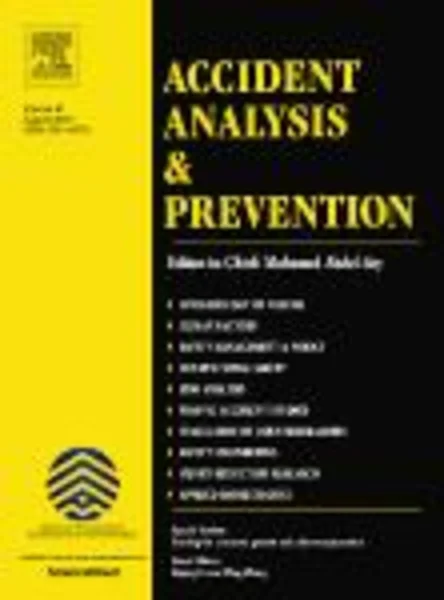-
measuring safety treatment effects using full bayes non-linear safety performance intervention functions
جزئیات بیشتر مقاله- تاریخ ارائه: 1392/01/01
- تاریخ انتشار در تی پی بین: 1392/01/01
- تعداد بازدید: 600
- تعداد پرسش و پاسخ ها: 0
- شماره تماس دبیرخانه رویداد: -
full bayes linear intervention models have been recently proposed to conduct before–after safety studies. these models assume linear slopes to represent the time and treatment effects across the treated and comparison sites. however, the linear slope assumption can only furnish some restricted treatment profiles. to overcome this problem, a first-order autoregressive (ar1) safety performance function (spf) that has a dynamic regression equation (known as the koyck model) is proposed. the non-linear ‘koyck’ model is compared to the linear intervention model in terms of inference, goodness-of-fit, and application. both models were used in association with the poisson-lognormal (pln) hierarchy to evaluate the safety performance of a sample of intersections that have been improved in the greater vancouver area. the two models were extended by incorporating random parameters to account for the correlation between sites within comparison–treatment pairs. another objective of the paper is to compute basic components related to the novelty effects, direct treatment effects, and indirect treatment effects and to provide simple expressions for the computation of these components in terms of the model parameters. the koyck model is shown to furnish a wider variety of treatment profiles than those of the linear intervention model. the analysis revealed that incorporating random parameters among matched comparison–treatment pairs in the specification of spfs can significantly improve the fit, while reducing the estimates of the extra-poisson variation. also, the proposed pln koyck model fitted the data much better than the poisson-lognormal linear intervention (plni) model. the novelty effects were short lived, the indirect (through traffic volumes) treatment effects were approximately within ±10%, whereas the direct treatment effects indicated a non-significant 6.5% reduction during the after period under plni compared to a significant 12.3% reduction in predicted collision counts under the pln koyck model.
مقالات جدیدترین رویدادها
-
استفاده از تحلیل اهمیت-عملکرد در ارائه الگوی مدیریت خلاقیت سازمانی و ارائه راهکار جهت بهبود
-
بررسی تاثیر ارزش وجوه نقد مازاد بر ساختار سرمایه شرکت های پذیرفته شده در بورس اوراق بهادار تهران
-
بررسی تأثیر سطح افشای ریسک بر قرارداد بدهی شرکت های پذیرفته شده در بورس اوراق بهادار تهران
-
بررسی تأثیر رتبه بندی اعتباری مبتنی بر مدل امتیاز بازار نوظهور بر نقد شوندگی سهام با تأکید بر خصوصی سازی شرکت ها
-
تأثیر آمیخته بازاریابی پوشاک ایرانی بر تصویر ذهنی مشتری پوشاک ایرانی (هاکوپیان)
-
فلسفه ی آموزش علوم
-
رفتار دینامیکی غیرخطی قاب های فولاد مجهز به میراگر فلزی تحت تاثیر زلزله های نزدیک گسل
-
انرژی های زمین شناختی و تعهدات زیست محیطی کارفرمایان (با نگاهی به قراردادهای بالادستی صنعت نفت و گاز ایران)
-
بررسی رابطه شادکامی، امید به زندگی و خلاقیت در دانش آموزان مقطع متوسطه
-
بررسی ارتباط سیستم اطلاعات پرستاری با کاهش استرس کاری پرستاران در بیمارستان های آموزشی زاهدان سال 1393
مقالات جدیدترین ژورنال ها
-
مدیریت و بررسی افسردگی دانش آموزان دختر مقطع متوسطه دوم در دروان کرونا در شهرستان دزفول
-
مدیریت و بررسی خرد سیاسی در اندیشه ی فردوسی در ادب ایران
-
واکاوی و مدیریت توصیفی قلمدان(جاکلیدی)ضریح در موزه آستان قدس رضوی
-
بررسی تاثیر خلاقیت، دانش و انگیزه کارکنان بر پیشنهادات نوآورانه کارکنان ( مورد مطالعه: هتل های 3 و 4 ستاره استان کرمان)
-
بررسی تاثیر کیفیت سیستم های اطلاعاتی بر تصمیم گیری موفق در شرکتهای تولیدی استان اصفهان (مورد مطالعه: مدیران شرکتهای تولیدی استان اصفهان)
-
تاثیر سواد بصری بر مصرف علائم و نشانه های مترو توسط مسافران در زندگی روزمره؛ مورد مطالعاتی: سیستم علائم و نشانه های مترو تهران
-
بررسی حقوقی ایجاب معلق
-
سرمایه اجتماعی گامی به سوی توسعه اجتماعی
-
ارائه راهکارهای پیشگیری و کاهش آسیب در زنان آسیب دیده اجتماعی با تاکید برآموزش
-
آثار قبض و رجوع در عقد هبه از منظر فقه امامیه و حقوق ایران




سوال خود را در مورد این مقاله مطرح نمایید :